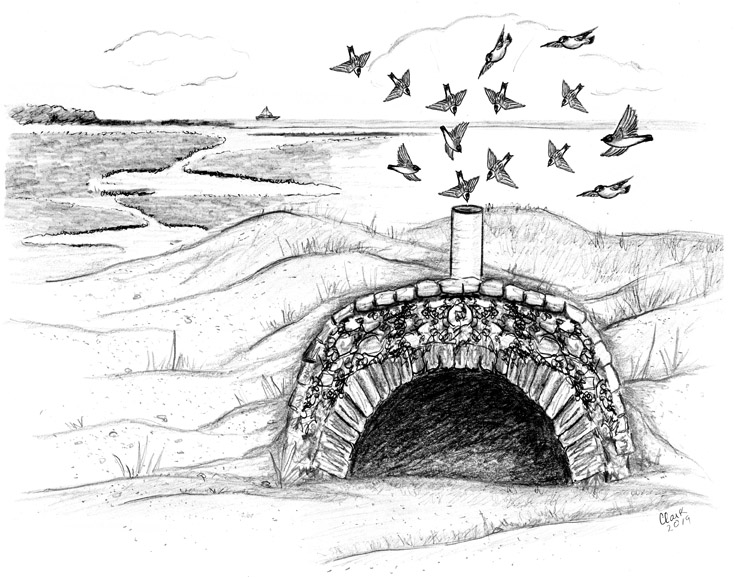
Dear Bird Folks,
I read in a recent post that Cave Swallows are breeding on Cape Cod. As far as I know, Cave Swallows generally breed in Texas. What brings them this far north?
– Josh, Kingston, MA
They’re a nice addition, Josh,
If you enjoy swallows, the Cape is a good place to live. Counting Purple Martins, there are six species of swallows annually seen on Cape Cod, and five of those six species breed here. But Cave Swallows have not been on that list. As you mentioned, they are normally found in Texas, with a few breeding in Southern Florida. However, in recent years, more and more of these swooping birds are being spotted in our area. The puzzling thing about Cave Swallows is that we see them gather in the fall and then they disappear, and are not spotted again along traditional migration routes. It’s as if they have simply vanished. Then an amazing discovery was made. This led to an even more amazing discovery, which created a huge buzz in both the birding and historical worlds.
The old idiom that humor often contains a kernel of truth has really hit home recently. For years, T-shirts, bumper stickers and wisecracking Cape Codders have made jokes about a “tunnel to Nantucket.” It turns out there is more truth to that gag than we all thought. A recent story in Popular Tunnel magazine outlined the W.W. II-era plan to construct an escape tunnel between Nantucket and Chatham. Who knew?
During the war, German U-boats constantly patrolled our Eastern shore. There was a concern that the Germans would invade Nantucket, thus giving them a foothold on American soil. The small island was ripe for the taking, as the residence had no real protection…except for a handful of old whale harpoons. If the Germans moved on the island, they would essentially hold the Nantucketers hostage, leaving the U.S. Military few options. (The Air Force couldn’t really bomb an island filled with American citizens…not to mention, scrimshaw.) A tunnel would allow the islanders (just a few thousand at the time) to escape to the mainland, leaving the Germans alone with the harpoons and scrimshaw.
The obvious location to construct this tunnel was from the tip of Monomoy Island, since it is the Cape’s closest point to Nantucket. But the military was worried the U-boats would notice the construction and invade before the escape route was completed. Instead, they selected Chatham’s Forest Beach as the access point. This would enable Monomoy’s beaches to conceal the project from German eyes. And since Forest Beach already had a huge communications tower on it, the government convinced the locals that the increased activity was all about the tower, keeping the tunnel scheme a total secret. (This was back when our government was clever at doing stuff.)
By May of 1945, the escape tunnel was nearly completed, which was good, but then something far better happened: Germany surrendered, the war in Europe was over, and so was the Nantucket Tunnel Project. Within a week all of the equipment and workers associated with the undertaking had vanished from the area. But instead of destroying the tunnel, the engineers simply capped it and covered it over (just in case they needed it again one day). For over seventy years this little piece of local history had been unknown, until it was rediscovered by, of all things, Cave Swallows.
Last fall, Joe Shenanigan, a birder from Boston, watched a steady stream of swallows disappear into the marsh behind Forest Beach. Curious, Joe waded into the tall grass, where he came upon a vent pipe. With his ear to the pipe, he could hear birds chirping and fluttering below the surface. The next day, he returned with a biologist from Mass Fish and Game who lowered a small video camera into the pipe. The two men were shocked by what they found. The chamber below them was filled with hundreds of previously unknown Cave Swallows. This discovery was a stunner, but where did the hidden chamber come from? Back in Boston the two men did some research and soon learned they had discovered the large subterranean entrance hall, leading to the long-rumored Nantucket tunnel. Nice find, Joe.
Throughout the winter, ornithologists watched the swallows via a remote camera. At first they assumed the birds would hibernate, but this was not the case. Even during the coldest months the swallows remained active in the relatively warm chamber. What did they eat? They fed on a population of what are now known as “tunnel flies.” But the ornithologists had a problem. The story had already broken in Popular Tunnel magazine. Birders were clambering to see the swallows, while historians, and other interested folks, wanted to see this forgotten piece of history. (Sadly, no one wanted to see the flies).
Finally, a compromise was reached. Biologists are convinced that once the Cave Swallows began building their nests, they would not be spooked by all the attention. In the meantime, workers have been clearing the chamber’s hidden entranceway, getting it ready for public viewing. I’ve seen early photos and the whole thing is pretty darn impressive, and surprisingly dry. Anyone interested in seeing the rare Cave Swallows, some local history and the long-rumored tunnel to Nantucket, should swing by Forest Beach for the grand opening, which will be at 10:00 AM, this Monday, April 1st.